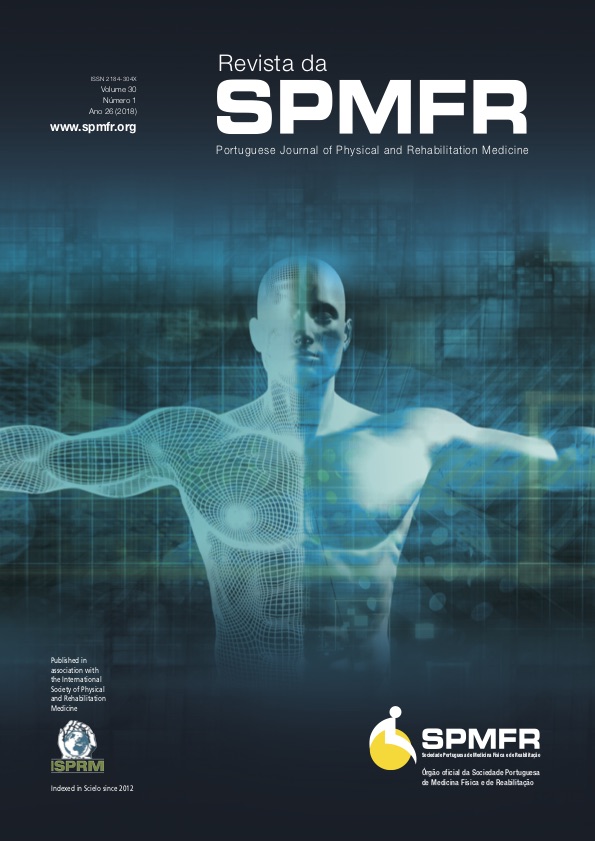Bilateral Foot Drop Following Compression Stockings Use
DOI:
https://doi.org/10.25759/spmfr.259Keywords:
Gait Disorders, Neurologic, Stockings, Compression, ThromboembolismAbstract
Compression stockings are commonly used for prophylaxis of deep venous thromboembolism after surgery and its effectiveness is well established. Peroneal nerve palsy is the most common entrapment neuropathy of the lower extremity. It can result from multiple causes but direct external compression of fibula head seems to be the main one. The authors report a 20-year-old female patient, who was submitted to a liver transplantation and after 25 days on Intensive Care Unit, rolled-down compression stockings were removed, and a linear impression mark below knee with bilateral foot drop was observed. The electrodiagnostic testing confirmed the diagnosis of a severe sensory-motor polyneuropathy. The aim of this report was to emphasize the importance of early recognition of the symptoms of peripheral nerve injury, especially in critical ill patients with multiple risk factors, who might have a worst outcome and permanent damage.
Downloads
References
Shalhoub J, Norrie J, Baker C, Bradbury AW, Dhillon K, Everington T, et al. Graduated compression stockings as an adjunct to low dose low molecular weight heparin in venous thromboembolism prevention in surgery: a multicentre randomised controlled trial. Eur J Vasc Endovasc Surg. 2017; 53:880-5. doi: 10.1016/j.ejvs.2017.02.013
Sajid MS, Desai M, Morris RW, Hamilton G. Knee length versus thigh length graduated compression stockings for prevention of deep vein thrombosis in postoperative surgical patients. Cochrane Database Syst Rev. 2012; 16:CD007162.
Wade R, Paton F, Rice S, Standsby G, Millner P, Flavell H, et al. Thigh length versus knee length antiembolism stockings for the prevention of deep vein thrombosis in postoperative surgical patients; a systematic review and network meta-analysis. BMJ Open. 2016; 6: e009456. doi: 10.1136/bmjopen-2015-009456.
Ayhan H, Iyigun E, Ince S, Fatih MC, Hatipoglu S, Saglam M. A randomized clinical trial comparing the patient comfort and efficacy of three different graduated compression stockings in the prevention of postoperative deep vein thrombosis. J Clin Nurs. 2015; 24:2247–57. doi: 10.1111/jocn.12866.
Sachdeva A, Dalton M, Amaragiri S, Lees T. Graduated compression stockings for prevention of deep vein thrombosis. Cochrane Database Syst Rev. 2014; 12:CD001484.
Hobson D, Chang T, Aboagye J, Lau B, Shibab H, Fisher B, et al. Prevalence of graduated compression stocking-associated pressure injuries in surgical intensive care units. J Crit Care. 2017; 40: 1-6. doi: 10.1016/j.jcrc.2017.02.016.
Hameed M, Browse D, Immelman E, Goldberg P. Should knee-length replace thigh-length graduated compression stockings in the prevention of deep-vein thrombosis? S Afr J Surg. 2002; 40:15–6.
Wade R, Paton F, Woolacott N. Systematic review of patient preference and adherence to the correct use of graduated compression stockings to prevent deep vein thrombosis in surgical patients. J Adv Nurs. 2017; 73:336-48. doi: 10.1111/jan.13148.
National Pressure Ulcer Advisory Panel. Pressure ulcer stages revised by NPUAP. [Accessed on May 2017] Available at: http://www.npuap.org/national-pressure-ulcer-advisory-panel-npuap-announces-a-changein-terminology-from-pressure-ulcer-to-pressure-injury-and-updates-thestages-of-pressure-injury/
Alderden J, Whitney JD, Taylor SM, Zaratkiewicz S. Risk profile characteristics associated with outcomes of hospital-acquired pressure injury: a retrospective review. Crit Care Nurse. 2011; 31:30–43.
Taraborelli M, Lazzaroni M, Martinazzi N, Fredi M, Cavazzana I, Franceschini F, et al. The role of clinically significant antiphospholipid antibodies in systemic lupus erythematosus. Reumatismo. 2016; 68: 137-43.
Bougea A, Anagnostou E, Konstantinos G, George P, Triantafyllou N, Kararizou E. A systematic review of peripheral and central nervous system involvement of rheumatoid arthritis, systemic lupus erythematosus, primary Sjögren's syndrome, and associated immunological profiles. Int J Chronic
Dis. 2015; 2015:910352.
Toledano P, Orueta R, Rodriguez-Pintó I, Valls-Solé J, Cervera R, Espinosa G. Peripheral nervous system involvement in systemic lupus erythematosus: prevalence, clinical and immunological characteristics, treatment and outcome of a large cohort from a single centre. Autoimmun Rev. 2017;16:750-5. doi: 10.1016/j.autrev.2017.05.011.
Güzelkücük Skempes D, Kumnerddee W. Common peroneal nerve palsy caused by compression stockings after surgery. Am J Phys Med Rehabil. 2014; 93: 609-11.
Poage C, Roth C, Scott B. Peroneal nerve palsy: evaluation and management. J Am Acad Orthop Surg. 2016; 24: 1-10. doi: 10.5435/JAAOS-D-16-00045.
Kim J, Kim W, Kim J, Choe W. Peroneal nerve palsy after compression stockings application. Saudi J Anesth. 2016; 10:462-4.
Arnold W, Elsheikh B. Entrapment neuropathies. Neurol Clin. 2013; 31:405–24.
Sprowson AP, Rankin K, Shand JE, Ferrier G. Common peroneal and posterior tibial ischemic nerve damage, a rare cause. Foot Ankle Surg. 2016; e16-e17. doi: 10.1016/j.fas.2009.04.003.
Brey JM, Castro MD. Salvage compartment syndrome of the leg and foot. Foot Ankle Clin. 2008; 13:767-72.
Winslow EH, Brosz DL. Graduated compression stockings in hospitalized postoperative patients: correctness of usage and size. Am J Nurs. 2008; 108: 40–50.
Downloads
Published
How to Cite
Issue
Section
License
Copyright statement
Authors must also submit a copyright statement (as seen below) on article submission.
To the Editor-in-chief of the SPMFR Journal:
The below signed author(s) hereby state that the article
________________________________________ (ref. MFR_________) is
an original unpublished work and all facts stated are a product of the author(s) investigation. This article does not violate any copyright laws or privacy statements. The author(s) also hereby confirm that there is no conflict of interest's issues in this article.
By submitting this article the author(s) agree that after publication all copyrights belong to the SPMFR Journal.
Signed by all authors
Date:
Names (capital letters):
Signatures:
The SPMFR Journal’s contents are follow a Creative Commons licence. After publication the authors can hand out the articles as long as the SPMFR Journal is credited.



